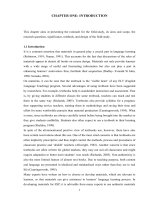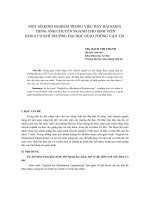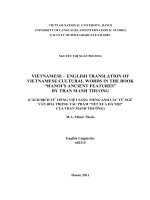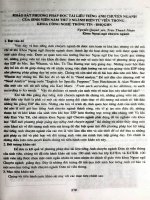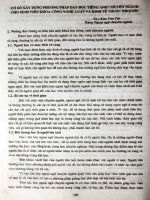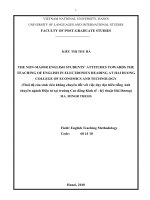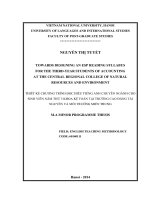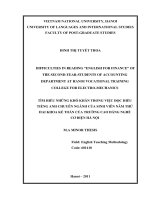Thiết kế chương trình đọc hiểu tiếng Anh chuyên ngành cho sinh viên năm thứ 3 khoa kế toán tại trường Cao đẳng Tài nguyên và Môi trường miền Trung
Bạn đang xem bản rút gọn của tài liệu. Xem và tải ngay bản đầy đủ của tài liệu tại đây (1.19 MB, 69 trang )
VIETNAM NATIONAL UNIVERSITY, HANOI
UNIVERSITY OF LANGUAGES AND INTERNATIONAL STUDIES
FACULTY OF POST-GRADUATE STUDIES
*************************
NGUYỄN THỊ TUYẾT
TOWARDS DESIGNING AN ESP READING SYLLABUS
FOR THE THIRD-YEAR STUDENTS OF ACCOUNTING
AT THE CENTRAL REGIONAL COLLEGE OF NATURAL
RESOURCES AND ENVIRONMENT
THIẾT KẾ CHƢƠNG TRÌNH ĐỌC HIỂU TIẾNG ANH CHUYÊN NGÀNH CHO
SINH VIÊN NĂM THỨ 3 KHOA KẾ TOÁN TẠI TRƢỜNG CAO ĐẲNG TÀI
NGUYÊN VÀ MÔI TRƢỜNG MIỀN TRUNG
M.A MINOR PROGRAMME THESIS
FIELD: ENGLISH TEACHING METHODOLOGY
CODE: 60140111
Hanoi - 2014
VIETNAM NATIONAL UNIVERSITY, HANOI
UNIVERSITY OF LANGUAGES AND INTERNATIONAL STUDIES
FACULTY OF POST-GRADUATE STUDIES
*************************
NGUYỄN THỊ TUYẾT
TOWARDS DESIGNING AN ESP READING SYLLABUS
FOR THE THIRD-YEAR STUDENTS OF ACCOUNTING
AT THE CENTRAL REGIONAL COLLEGE OF NATURAL
RESOURCES AND ENVIRONMENT
THIẾT KẾ CHƢƠNG TRÌNH ĐỌC HIỂU TIẾNG ANH CHUYÊN NGÀNH CHO
SINH VIÊN NĂM THỨ 3 KHOA KẾ TOÁN TẠI TRƢỜNG CAO ĐẲNG TÀI
NGUYÊN VÀ MÔI TRƢỜNG MIỀN TRUNG
M.A MINOR PROGRAMME THESIS
FIELD: ENGLISH TEACHING METHODOLOGY
CODE: 60140111
SUPERVISOR: DR. NGƠ HỮU HỒNG
Hanoi - 2014
DECLARATION
I hereby certify that the thesis entitled
“Towards designing an ESP reading syllabus for the third-year students of
Accounting at the Central Regional College of Natural Resources and
Environment”
is the result of my own research for the Degree of Master of Arts at University of
Languages and International Studies, Vietnam National University, and that this
thesis has not been submitted for any degree at any other university or tertiary
institution.
Hanoi, 2014
Student‟s signature
Nguyễn Thị Tuyết
i
ACKNOWLEDGEMENTS
First and foremost, I would like to express my profound gratitude to my supervisor,
Dr. Ngơ Hữu Hồng, for his valuable instructions, constructive criticisms and his
kindly encouragement during the development of this thesis. Without his guidance
the thesis would have been impossible.
My special thanks go to all professors and lecturers at the Faculty of Post-Graduate
Studies, University of Languages and International Studies – VNU for their useful
lectures, helpful suggestions, and tireless assistance.
I am also grateful to my colleagues and the third-year students of Accounting at
Central Regional College of Natural Resources and Environment for their
invaluable feedback, support and participation in this research.
Finally, to my beloved family go my heart-felt thanks for their understanding as
well as their help throughout my graduate program.
ii
ABSTRACT
The purpose of this study is collecting sufficient and necessary information so as to
design an ESP reading syllabus for the third-year students of accounting at the
Central Regional College of Natural Resources and Environment. It is hoped that
the syllabus will benefit both students and teachers alike in teaching and learning
English at the Central Regional College of Natural Resources and Environment.
The study begins with the review of theoretical background concerning areas of
ESP, syllabus design and needs analysis. It continues with the teaching and learning
context at the CRCNRE to show that it is a must to design a reading syllabus for the
third-year students of accounting at CRCNRE. Then an investigation of target needs
and learning needs to identify areas to be developed in the syllabus. The data
collection instruments manipulated is questionnaires, discussion and interviews.
The data were collected from different sources: the ESP teachers, the subject
teachers, the third-year students of Accounting and the working accountants in NRE
sector. After the data were carefully analyzed, the author decided to choose a topicbased syllabus. Based on the results of the needs analysis, an ESP reading syllabus
is proposed.
The expected ESP reading syllabus is supposed to enrich students‟ specific terms as
well as develop their reading skill to enable them to comprehend reading materials
related to accounting and accomplish relevant simple tasks in the job as accountants
in the natural resources and environment sector.
iii
LIST OF ABBREVIATIONS
CBI:
Content-Based Instruction
CRCNRE: Central Regional College of Natural Resources and Environment
CV:
Curriculum Vitae
EAP:
English for Academic Purposes
EFL:
English as a Foreign Language
EGP:
English for General Purposes
ELT:
English Language Teaching
EOP:
English for Occupational Purposes
ESL:
English as a Second Language
ESP:
English for Specific Purposes
GE:
General English
IT:
Information Technology
M.A.:
Master of Arts
MOET:
Ministry of Education and Training
NRE:
Natural Resources and Environment
TVET:
Technical and Vocational Education and Training
ULIS:
University of Languages and International Studies
VNU:
Vietnam National University, Hanoi
WOW:
World of Work
iv
LIST OF CHARTS, FIGURES AND TABLES
Chart 1: Students‟ opinions about their level of English………………………
19
Chart 2: Students‟ opinions on the importance of reading skills………………
20
Chart 3. Students‟ attitudes towards ESP………………………………………
20
Figure 1. The Tree of ELT……………………………………………………...
5
Table 1: Teachers‟ expectations of the ESP reading course ……………………
15
Table 2: Teachers‟ opinion of topics relating to Accounting…………………..
16
Table 3: Exercises to be included in the syllabus perceived by the teachers……
17
Table 4: Students‟ opinion on the benefit of the ESP reading course…………
21
Table 5: Students‟ opinions about the objectives of the ESP reading course.....
21
Table 6: Students‟ opinions about the topics needed for the ESP syllabus……
23
Table 7: Students‟ opinions on exercises to be included in the syllabus ……….
25
Table 8: The proposed syllabus for the third-year students of accounting
at CRCNRE………………………………………………………………………
v
35
TABLE OF CONTENTS
DECLARATION ......................................................................................................... i
ACKNOWLEDGEMENTS ........................................................................................ii
ABSTRACT .............................................................................................................. iii
LIST OF ABBREVIATIONS .................................................................................... iv
LIST OF CHARTS, FIGURES AND TABLES ......................................................... v
TABLE OF CONTENTS ........................................................................................... vi
PART I: INTRODUCTION ........................................................................................ 1
1. Rationale ............................................................................................................. 1
2. Aims of the study ................................................................................................ 1
3. Research questions .............................................................................................. 2
4. Significance of the study ..................................................................................... 2
5. Methods of the study ........................................................................................... 3
6. Structure of the thesis .......................................................................................... 3
PART II: DEVELOPMENT ....................................................................................... 4
CHAPTER 1: LITERATURE REVIEW .................................................................... 4
1.1. Definitions of ESP............................................................................................ 4
1.1.1. ESP ............................................................................................................ 4
1.1.2. ESP in practice in Vietnam ....................................................................... 5
1.2. ESP Syllabus Design ........................................................................................ 7
1.2.1. Approaches to ESP syllabus design and types of syllabus ....................... 7
1.2.2. Steps in ESP syllabus design .................................................................... 8
1.3. Chapter summary ............................................................................................. 8
CHAPTER 2: METHODOLOGY .............................................................................. 9
2.1. The CRCNRE context ...................................................................................... 9
2.1.1. The context of teaching and learning English at CRCNRE ...................... 9
2.1.2. The teachers of English at CRCNRE ...................................................... 10
2.1.3. The target students .................................................................................. 10
2.2. Research questions revisited .......................................................................... 11
2.3. The participants .............................................................................................. 11
2.4. Methods and instruments ............................................................................... 11
2.4.1. Data collection instruments ..................................................................... 11
vi
2.4.2. Data collection procedures ...................................................................... 12
2.5. Chapter summary ........................................................................................... 13
CHAPTER 3: DATA ANALYSIS, FINDINGS AND THE PROPOSED ESP
SYLLABUS .............................................................................................................. 14
3.1. Data analysis .................................................................................................. 14
3.1.1. Data from the questionnaires CRCNRE teachers of English .................. 14
3.1.2. Data from the questionnaires to CRCNRE students of Accounting ....... 19
3.1.3. Data from the interviews with the subject teachers ................................ 26
3.1.4. Data from discussions with the working accountants in the NRE sector27
3.2. Findings and discussion ................................................................................. 28
3.2.1. Needs perceived by CRCNRE students of Accounting .......................... 28
3.2.2. Needs perceived by working accountants in NRE sector ....................... 29
3.2.3. Needs perceived by the subject teachers ................................................. 29
3.2.4. Needs perceived by CRCNRE teachers of English ................................ 30
3.3. The proposed ESP reading syllabus for students of Accounting at
CRCNRE ............................................................................................................... 32
3.3.1. Type of the syllabus ................................................................................ 33
3.3.2. Objectives of the course .......................................................................... 34
3.3.3. Structure of the syllabus .......................................................................... 34
3.3.4. Assessment .............................................................................................. 37
PART III: CONCLUSION ........................................................................................ 38
1. Conclusion ......................................................................................................... 38
2. Limitations ........................................................................................................ 39
3. Suggestions for further studies .......................................................................... 39
REFERENCES .......................................................................................................... 40
APPENDICES............................................................................................................. I
Appendix 1 .............................................................................................................. I
Appendix 2 ............................................................................................................. V
Appendix 3 ............................................................................................................. X
Appendix 4 ............................................................................................................XI
A sample lesson for Unit 2 .................................................................................. XII
vii
PART I: INTRODUCTION
1. Rationale
As students in Vietnam continue to gain higher awareness of what they are
expected to do in their jobs upon graduation, particularly now that what they
need to be able to do with English is more visibly and rigorously articulated,
educational service providers in the country cannot go on offering students what
is not industry relevant. As one among such training institutions, our Central
Regional College of Natural Resources and Environment (CRCNRE) cannot
stand out of the trend. This requires us – teachers of English at the College – to
develop English courses, especially courses on English for Specific Purposes
(ESP) to satisfy those demands.
Currently, we are using a number of textbooks to develop our lessons for
students of different majors, and applying certain teaching schedules, but a
proper syllabus, which must come before the choice of materials, and must be
based upon specific needs, has not availed, particularly a syllabus for students of
Accounting I am teaching. For these reasons, I decided to conduct this study for
designing an ESP reading syllabus for students of Accounting at the Central
Regional College of Natural Resources and Environment.
2. Aims of the study
As indicated in the research title, this study was conducted to identify:
Target needs: what students of accounting at CRCNRE expect and are
expected to know and be able to do with English in terms of the tasks and
functions of an accountant in the field of natural resources and environment by
the end of this course, which, together with other courses provided by CRCNRE,
can make them job-ready;
Learning needs: what they need to do so as to learn and make up for what
they are still lack so that they can reach the expected outcomes.
The ultimate aim of understanding all these was to design a proper need-driven
ESP reading syllabus for this particular group of students. It was our awareness
1
that these target and learning needs could be diverse and could not be satisfied by
a mere 45-hour reading course like this. Taken Hutchinson and Waters‟ analogy
of an ESP “journey”, with Hà Nội as the point of departure and Thanh Hoá as the
target destination to these students, it was hoped that this ESP reading course
could bring them to our little town of Bỉm Sơn where CRCNRE is located, which
is more than half-way between Hà Nội and Thanh Hoá, with the remaining
distance to be covered for the rest of their college experience.
3. Research questions
In order for sufficient and necessary data and information to be collected, the
following three major questions were answered, namely:
1. What are the expectations of the target learners for whom the syllabus is
to be designed?
2. What are they required to do in their jobs as accountants in the field of
natural resources and environment, and what are they required to do with English
in those jobs in particular?
3. What should be presented in the intended ESP reading syllabus so as to
cover most, if not all, of the types of needs identified to the extent possible
within the 45-hour limit given?
4. Significance of the study
The only theoretical contribution this study is hoped to make is the assertion
of one among different and even controversial interpretations and applications of
the concept English for Specific Purposes (ESP) in the country. Meanwhile, the
study‟s practical significance lies in its output: a proper learnable/teachable ESP
reading syllabus for students of accounting in the NRE sector which would be an
effective and convenient tool for both teachers of English and students in
CRCNRE. Also, this clearly shows the tangible product of our learning in the
M.A program at ULIS and is ultimately another effort for the common goal of
improving English proficiency among our students.
2
5. Methods of the study
In order to identify the target need of the learners for whom the syllabus is
to be designed, questionnaires were given out to collect data from the teachers of
English and the third-year students of Accounting at the CRCNRE. In addition,
to identify the requirements for their jobs as accountants, interviews were carried
out with subject teachers and discussions with some working accountants in the
field of natural resources and environment. These provided me with information
to establish the target needs and consequently their learning needs.
6. Structure of the thesis
This thesis is organized as follows:
PART I: INTRODUCTION - introduces the rationale; aims of the study;
research questions; significance of the study; methods; and the thesis structure.
PART II: DEVELOPMENT - which is the main part of the study, consists of
three chapters: Chapter 1: LITERATURE REVIEW – presents an overview of
relevant theoretical concepts and premises for the study, including definitions of
ESP and types of syllabus; discusses approaches to syllabus design and ESP
syllabus design in particular, and theories of reading that the syllabus being
designed would be based on. Chapter 2: METHODOLOGY – describes the
participants and CRCNRE context, restates the research questions, methods and
instruments. Chapter 3:DATA ANALYSIS, FINDINGS AND THE PROPOSED
ESP SYLLABUS – analyses the data gathered and discusses the findings out of
that analysis, presents the output of the study, i.e. the ESP reading syllabus.
PART III: CONCLUSION - offers a summary of the study, limitations and
suggestions for further research.
3
PART II: DEVELOPMENT
CHAPTER 1: LITERATURE REVIEW
1.1. Definitions of ESP
1.1.1. ESP
To date, there have been a variety of views and definitions of English for
Specific Purposes (ESP) in contrast with General English (GE), such as those
suggested by Munby (1978), Kennedy and Bolitho (1984), Robinson (1991),
Dudley-Evans (1998), etc. Most of the authors agree that ESP courses are those
entirely governed by the communicative needs of the learner with regards to the
curriculum and teaching/learning materials (Munby, 1978), or those based on the
learner‟s purposes identified through investigations and their communicative
needs generated from those purposes (Kennedy and Bolitho, 1984). Meanwhile,
Robinson (1991) believes that ESP aims at the final goals and is based on needs
analysis, which informs the course designers of what the learner expects and is
expected to be able to perform through the means of English. Despite individual
differences in their wording, these conceptualizations center round a common
core: the specific needs of the learner.
Carrying these views further, Dudley-Evans (1998) identifies ESP as containing
such characteristics as the following:
i. An ESP course is designed to satisfy specific needs of the learner;
ii. It applies the methods and [linguistic] activities of the discipline or field it
serves;
iii. It focuses on the type of language relevant to those activities in terms of
grammar, vocabulary, style, register, discourse and rhetorics, to name just a
few.
In most cases, ESP is dedicated to adult learners at tertiary, vocational education
and training service providers, or working at particular institutions. These
learners tend to start from the intermediate or advanced level, i.e. they have
already had a fundamental command of English. In other words, they have
4
reached a considerable level of GE before commencing their ESP course. This
also means that ESP may not be suitable for complete beginners, and helps
distinguish GE from ESP.
According to Hutchinson and Waters (1987:17), ESP can comprise several
branches, as the tree below clearly displays.
Figure 1. The Tree of ELT (Hutchinson and Waters, 1987:17)
1.1.2. ESP in practice in Vietnam
Since the early 1990s, progress has been made in the perception towards foreign
language teaching in the country, which has brought about positive changes to
5
both the curricula and teaching methodology. A brief look at some English
curricula accessible to us below can help illustrate this point.
The English program for technical and vocational schools developed by Lê
Ngọc Tƣờng et al (2002: 6) clearly points out, “the program … is topic-based,
i.e. topics serve as the basis for selecting reading materials, exercises and
activities in each unit; they govern the linguistic content of the program.” The
program thus aims at the target careers and/or professions of the learners.
Nevertheless, given the variety of technical and vocational schools in the
country, the topics identified in the program remain generic and suggestive in
their nature, which requires each technical and vocational education and training
(TVET) provider to continue to specify them further for their own students.
The ESP Reading Syllabus for 2nd-year Students of Plants and Vegetation at Tây
Nguyên University by Ngô Văn Thông (2004) is also topic-based, with reading
sub-skills and grammar sections similar to any GE course. The most typical ESP
elements lie in the vocabulary introduced, for instance, Unit 1 on traditional rice
cultivation, Unit 4 on water resources and irrigation works, Unit 5 on agricultural
machinery and technical equipment.
However, strategies for vocabulary
building and professional terminology development as well as the linguistic
rhetorics and register of the field remain unclear.
In the same vein, the ESP Reading Syllabus for 2nd-year Students of InformaticsElectronics at Dak Lak Technical College by Trần Thị Cẩm Linh (2004)
suggested topics like Unit 1 - What is a computer?, Unit 2 – How do computer
systems process data?, Unit 5 – Disks and Disk Drives, which demonstrate the
author‟s efforts to associate language skills with their communicative functions,
e.g. descriptions of components and characteristics, giving instructions, or
explaining procedures. Again, like the ESP course on Plants and Vegetation
above, this syllabus does not make it clear how many entries there should be in
these IT students‟ lexicon, or what makes IT English register differ from English
used in other areas of study. By and large, these two syllabi are more EAP- than
EOP-oriented.
6
Unlike the above, the ESP Listening-Speaking Syllabus for 3rd-year Students of
Hotel Management at Phuong Dong University by Trịnh Thị Nha Trang (2004)
tried to combine topics with communicative situations and functions, with
situations highly predominant. For example, Unit 2 – Hotel Check-in contains
listening and speaking activities in possible situations at hotel front office, while
Unit 4 – Food Service centers around various situations which are likely to occur
in restaurants. Topics in the course evolve as a sequential journey from the time
a guest books a hotel room, prepares to depart, arrives at the hotel to the time
he/she pays and leaves. EOP for hotel management staff is the apparent
orientation governing this course.
Scanning several other M.A. theses with the same purposes of ESP syllabus
design, either in listening, speaking or reading, particularly those on reading,
which are directly relevant to our study, e.g. Đặng Thị Lệ Quyên (2014), Nguyễn
Thị Thanh Hà (2011), etc., we can see a similar topic-based trend in their design:
they start with topics, then proceed to the particular reading sub-skills to be
practiced; next come the linguistic items (lexical resources, technical terms,
grammatical structures, etc.) related to the topics and reading sub-skills, and
finally other tasks like translation or some integrated skills of speaking, writing
or listening based on the reading. Realizing the strengths and weaknesses of
these courses, and taking into account the particular needs of the students of
Accounting at CRCNRE, we hope to be able to create a more appropriate ESP
syllabus on the basis of the study.
1.2. ESP Syllabus Design
1.2.1. Approaches to ESP syllabus design and types of syllabus
According to Hutchinson and Waters (1987) there are probably as many different
approaches to ESP course design as there are course designers. They identify
three main types: language-centered, skill-centered and learning-centered. These
result in different types of syllabus, for instance the structural-grammatical
syllabus, the situational syllabus, the functional/notional syllabus, the task-based
syllabus, the topic-based syllabus, the skill-based syllabus. Each syllabus type
7
has its own advantages and disadvantages, so the researcher intends to adopt a
mix of topic-based and task-based approaches in designing the course, which
focuses more on language use in particular tasks that NRE-sector accountants
will have to fulfill in their day to day jobs. The reasons for this choice will be
further clarified in Chapters 2 and 3 of the thesis with reference to the needs
identified.
1.2.2. Steps in ESP syllabus design
According to Nunan (1985:7), in designing a syllabus, the most important step is
analyzing the learner‟s needs. Yalden (1983) also has the same idea. He also
suggested 5 following steps in syllabus design:
Needs analysis Objectives and aims Sequencing Teaching method
Testing and evaluation.
Graves (1996:13) proposes a more detailed framework with seven steps
including needs assessment, determining goals and objectives, conceptualizing
content, selecting and developing materials and activities, organization of
content and activities, evaluation and consideration of resources and constraints.
The following chapters will demonstrate how these steps were used in this study.
1.3. Chapter summary
So far, this chapter has presented key definitions of ESP followed by a
summative account of several ESP syllabi designed in the country. The chapter
then briefly mentions some essential considerations in ESP syllabus design to
help us in this study. The following chapters will demonstrate the work done
throughout these stages of the design process.
8
CHAPTER 2: METHODOLOGY
2.1. The CRCNRE context
2.1.1. The context of teaching and learning English at CRCNRE
CRCNRE is located in Bỉm Sơn town, Thanh Hóa province. The college
is established on the basis of Central Vocational School of Natural Resources
and Environment founded in 1969. The School is responsible for training
professionals in environment, land management, surveying with vocational
primary and intermediate level in Central Vietnam.
Since 1996, General English (GE) has been taught at CRCNRE and ESP
was brought into the school curriculum in 2008. The students of all faculties
learn the same GE program in the same period of time but students of different
majors learn different ESP courses. At present, the students of Accounting learn
150 periods of GE in their first year with 75 periods each term. In their third year
they learn 45 periods of ESP after finishing some Vietnamese professional
subjects such as Accounting principles, Finance, Financial Accounting, theories
of monetary, Macro and Micro economics, Marketing, Business management,
Business Statistics, Auditing and so on.
In the stage of GE, with the allocation of 150 periods, the teacher and the
students have to cover 15 units of the textbook “Lifelines” (Elementary) by Tom
Hutchinson, 2004. Therefore, several writing, speaking, reading and listening
tasks have to be taken. Besides, the teachers of English often have formal
discussion on how to adapt the material or to find out a suitable way to teach.
However, the result of English teaching/learning is not very satisfactory. There
are many factors involved such as students‟ low level of English, students‟ low
motivation, their unsuitable learning strategies…
For the stage of ESP, the lack of teaching materials is the most serious
problem. Without a suitable program, the teachers have to collect and edit their
own materials from the published books or from the Internet. Not being carefully
designed, these materials seem to be too difficult for the students. Some topics
9
are not relevant to their needs. Furthermore, these materials do not provide
teachers with additional exercises, tests or reviews. This means that students
have no opportunities to review by themselves and teachers must take a lot of
time to prepare reviews and tests. Obviously, the lack of an appropriate syllabus
has a bad effect on the teaching and learning process. Therefore, designing an
ESP reading syllabus, which is suitable for the students‟ ability, needs and
interests, is an urgent task.
2.1.2. The teachers of English at CRCNRE
There are 6 teachers of English at CRCNRE, aged from 28 to 40. Two of them
are working towards an M.A degree, two of them have M.A degrees, the other
two have Bachelor degrees in English. All the teachers have to teach both GE
and ESP because there are many English courses at the CRCNRE. Though most
of them are experienced and enthusiastic in teaching GE, none of them have
experience in teaching ESP and they have never taken any courses about ESP
teaching method. Moreover, when teaching ESP, the teachers of English do not
have sufficient knowledge about the specialist field. Therefore, it is difficult for
them to comprehend the subject matter. In addition, because of the lack of
suitable teaching materials written in English, the teachers sometimes have to
translate from the Vietnamese books, consult the subject teachers and find
materials from other sources to provide the learning materials for the students.
2.1.3. The target students
The target students are the third-year students of Accounting at the CRCNRE
who have already finished GE. These students are young, aged from 19 to 25,
most of them are female; and their English is not good. Therefore, teachers
encounter many difficulties in teaching them. To make the matter worse, they are
a bit pasive and hardly ever try their best. Furthermore, the students at the
CRCNRE are not interested in learning English. They are not students of English
major, so they do not devote themselves to learning and they do not know the
way to learn a foreign language. However, the third-year students of Accounting
at the CRCNRE seems to have higher motivation, since they are now aware of
10
the significance of English, especially ESP, in their study as well as in their
future jobs.
2.2. Research questions revisited
This study is carried out to answer the following questions:
1. What are the expectations of the target learners for whom the syllabus is
to be designed?
2. What are they required to do in their jobs as accountants in the field of
natural resources and environment, and what are they required to do with English
in those jobs in particular?
3. What should be presented in the intended ESP reading syllabus so as to
cover all the types of needs identified to the extent possible within the 45-hour
limit given?
2.3. The participants
The study is aimed at designing a syllabus for the third-year students of
Accounting at the CRCNRE, so the participants in the study are 50 third-year
students of Accounting. They have finished their GE course at the CRCNRE. In
addition, 3 working accountants at NRE sector, 6 teachers of English at the
CRCNRE who are to conduct the course and 5 subject teachers of Accounting
Faculty also participated in the study.
2.4. Methods and instruments
2.4.1. Data collection instruments
The instruments for data collection adopted in this study were (1) questionnaires
for the teachers of English at CRCNRE, (2) questionnaires for the third-year
students of Accounting, (3) interviews with subject teachers and discussions with
working accountants in the NRE sector.
Questionnaire 1 (See Appendix 1): administered to 6 teachers of the English
group at the CRCNRE includes 3 questions concerning the objectives of the
syllabus, and suggested topics and exercises in the syllabus.
Questionnaire 2 was designed for the 50 third-year students of Accounting at
the CRCNRE and was written in Vietnamese in order to assure the proper
11
understanding of the questions. This questionnaire has seven questions, which
are detailed in Appendix 2.
Interviews (See Appendix 3) were conducted with 5 subject teachers from the
Accounting faculty. The purpose of the interviews with the subject teachers was
to obtain the teachers‟ opinion on the ESP course, their recommendations and
expectations about the objectives of the course, the topics and exercises needed
for the syllabus.
Discussions (See Appendix 4) with 3 working accountants at NRE sector were
employed to find out their opinion about the subject and their experience in
performing the real world tasks of an accountant.
2.4.2. Data collection procedures
In order to gather as exact information as possible, the researcher divided the
needs analysis into following steps:
Step 1: The context of ESP learning and teaching at CRCNRE was analyzed to
obtain preliminar understanding of the target students;
Step 2: The researcher selected the instruments to be used, identified the
participants involved in the study and outline the procedures of data collection;
Step 3. Administering of the questionnaires
First, questionnaires including both open- and closed-ended questions were
developed for teachers of the English and the target students based on the
theoretical framework of the study. In May 2014, the questionnaire for the
teachers was administered at the break time of the English group‟s weekly
meeting. Also in May 2014, an informal meeting was held by the researcher with
the participating students. Before administrating the questionnaires, the
participants (both the teachers and the students) were informed of their purposes.
Explanation of each item in the questionnaires was given. Any ambiguity found
by the participants was made clear. No recommendation on answer choice was
given, however. The questionnaire for the teachers was gathered after several
days and the questionnaire for the students was collected after 1 hour of
administration. The data received from these two questionnaires were imported
12
into the computer and treated in Excel. The data were then subjected to some
descriptive and inferential statistics. For accurate and effective interpretation of
data, the author used frequencies to find out the percentage that indicate more
emphasis given to each item.
Step 4: Conducting interviews and discussions
In May 2014, five interviews were conducted with the subject teachers of the
Accounting Faculty on the basis of the theoretical framework of the study. The
interview questions were semi-structured with open-ended items. Appointments
were made with these teachers prior to interviews. The teachers were informed
of the purpose of the interviews, which is to serve the aim of the researcher‟s
thesis and which is not for any personal evaluation.
Also in May 2014, three discussions were carried out with the three working
accountant at NRE sector. The discussions were casual conversations between
the researcher and the participants. The researcher noted down what the
informants responded as handwritten records.
Step 5: The researcher analyzed the collected data from questionaires, interviews
and discussions.
2.5. Chapter summary
This chapter has described the context of teaching and learning English at
CRCNRE, the teachers of English there and the target students. Then the
research methodology is given, including reiteration of the research questions,
the participants, data collection instruments and procedures. The data collected
will be then analyzed to yield essential findings, including needs perceived by
different groups of participants. The needs identified will be critical inputs for
the design of the syllabus in the next chapter.
13
CHAPTER 3: DATA ANALYSIS, FINDINGS AND THE PROPOSED ESP
SYLLABUS
3.1. Data analysis
This section presents the data collected from the questionnaires for the teachers
of English and the students of Accouting as well as the results of the interviews
and discussions with the subject teachers and the working accountants.
3.1.1. Data from the questionnaires CRCNRE teachers of English
Question I: Teachers’ ideas on the objectives of the ESP reading course
The aim of this question is to find out the teachers‟ expectations about the
objectives of the ESP reading course. There are seven objectives for the teachers
to arrange in order of significance from the most significant to the least
significant. The teachers also have a chance to suggest any objectives of their
own. Their responses are presented in Table 1 on the following page.
As can be seen from Table 1, 100% of the teachers agreed with the objectives
listed by the questionnaire designer because no other idea was offered. The most
important objective of the reading course is item 2 since the highest percentage
of the teachers (66.6%) put it in the first priority. The second important objective
is given to item 6 chosen by 50% of the teachers. Ranking the third is item 4 by
33.3% of responses. Item 3 also receives an emphasis by the teachers as it has a
total of 66.6% of the responses in the first three priorities. The results indicate
that the teachers would like to help their students to be able to understand both
the concepts and the relevant written materials related to Accounting after
finishing the ESP course basing on the specific terms obtained in the learning
process. The remaining items which occupy low percentages suggest that
grammar and speaking skill are not highly important for the course. This can be
explained by the fact that in General English course, grammar was already given
much emphasis and mastering speaking skill in the limited time of an ESP
reading course would be too difficult.
14
Table 1: Teachers’ expectations of the ESP reading course
Priority
Items
Objectives
1st
1
2
3
4
5
6
7
To define
Accounting
terms in
English
To read and
understand
concepts of
Accounting
To build up
English terms
relating to
Accounting
To translate
key
information in
Accounting
materials into
Vietnamese
and vice versa
To review and
consolidate
basic
grammatical
structures
used in
specialized
texts for
Accounting
To read and
understand
relevant
materials
related to
Accounting
To
communicate
in English
with
foreigners on
familiar topics
in Accounting
2nd
0
(0%)
0
(0%)
4
(66.6%)
1
(16.7%)
0
(0%)
2
(33.3%)
3rd
4th
5th
6th
7th
0
(0%)
2
(33.3%)
1
(16.7%)
2
(33.3%)
1
(16.7%)
0
(0%)
1
(16.7%)
0
(0 %)
0
(0 %)
0
(0 %)
2
(33.3%)
1
(16.7%)
1
(16.7%)
0
(0%)
0
(0%)
2
(33.3%)
2
(33.3%)
1
(16.7%)
0
(0%)
1
(16.7%)
0
(0%)
0
(0%)
0
(0%)
0
(0%)
0
(0%)
0
(0%)
2
(33.3%)
2
(33.3%)
2
(33.4%)
3
(50%)
2
(33.3%)
1
(16.7%)
0
(0%)
0
(0%)
0
(0%)
0
(0%)
0
(0%)
0
(0%)
1
(16.6%)
0
(0%)
1
(16.7%)
1
(16.7%)
3
(50%)
15
Question II: Topics related to Accounting as perceived by the teachers.
Fifteen topics were chosen by the ESP teachers from the themes presented and
recommended in the course for Accounting in Vietnamese. The teachers were
asked to rank the topics from necessary to not necessary. An opportunity was open
for the teachers to add any topics which they think are necessary. The number and
percentage of people responding to each item is shown in Table 2 below.
Table 2: Teachers’ opinion of topics relating to Accounting
Items
Topics
Very
Necessary
1.
Introduction to Accounting
2.
Accounting and Accountants
3.
Cost Accounting
4.
Not
necessary
necessary
Slightly
necessary
Environmental Economics
and Environmental
0 (0%)
3 (50%)
3 (50%)
0 (0%)
6 (100%)
0 (0%)
0 (0%)
0 (0%)
0 (0%)
1 (16.7%)
2 (33.3%)
3 (50%)
5 (83.3%)
1 (16.7%)
0 (0%)
0 (0%)
Accounting
5.
Management accounting
1 (16.7%)
0 (0%)
2 (33.3%)
3 (50%)
6.
Sales and Marketing
2 (33.3%)
3 (50%)
1 (16.7%)
0 (0%)
7.
Business Transaction and
3 (50%)
2 (33.3%)
1 (16.7%)
0 (0%)
1 (16.7%)
0 (0%)
0 (0%)
5 (83.3%)
6 (100%)
0 (0%)
0 (0%)
0 (0%)
0 (0 %)
1 (16.7%)
1 (16.7%)
4 (66.6%)
Financial Statements
8.
Auditing
9.
Resources and
Environmental Audit
10.
Investment
11.
Taxation
2 (33.3%)
3 (50%)
0 (0%)
1 (16.7%)
12.
Importing and Exporting
1 (16.7%)
4 (66.6%)
1 (16.7%)
0 (0%)
13.
Resources and Environ-
5 (83.3%)
1 (16.7%)
0 (0%)
0 (0%)
0 (0%)
0 (0%)
0 (0%)
6 (100%)
0 (0%)
3 (50%)
1 (16.7%)
2 (33.3%)
mental Finance
14.
Economic Systems
15.
Financial statements and
ratios
The data from Table 2 shows that the teachers added no other topics. The topics
which have highest percentage of 80% or 100% positive responses (very
16

